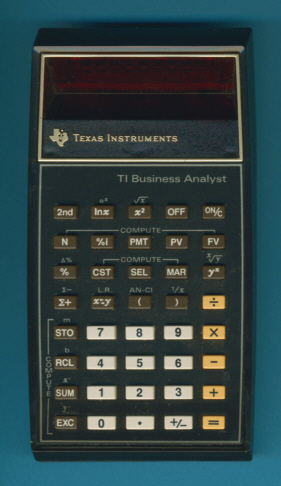
DATAMATH CALCULATOR MUSEUM
 |
DATAMATH CALCULATOR MUSEUM |
Texas Instruments TI Business Analyst
| Date of introduction: | June 13, 1976 | Display technology: | LED-stick |
| New price: | $49.95 | Display size: | 8 (5 + 2) |
| Size: | 5.8" x 3.1" x
1.4" 148 x 78 x 36 mm3 |
||
| Weight: | 4.0 ounces, 114 grams | Serial No: | 3680059 |
| Batteries: | BP5, BP8 | Date of manufacture: | wk 26 year 1978 |
| AC-Adapter: | AC9131, AC9132 | Origin of manufacture: | USA (ATA) |
| Precision: | 11 | Integrated circuits: | TMC0982 |
| Logic: | AOS - 4 Pending Operations, 15 () | ||
| Memories: | 1 | ||
| Program steps: | Courtesy of: | Joerg Woerner | |
| Download leaflet: | |
Download manual: | |

![]()
 The
Business Analyst was introduced mid of 1976 together with the entry calculator TI-30
and the SR-40. The technology behind the Business
Analyst was identical to the SR-40 and is described there.
The
Business Analyst was introduced mid of 1976 together with the entry calculator TI-30
and the SR-40. The technology behind the Business
Analyst was identical to the SR-40 and is described there.
The Business Analyst was the first in a successful line
targeting financial calculations. It continued with the face-lifted Business
Analyst I, the LCD model Business Analyst II and you'll find in each
scientific/programmable epoch a financial variant.
The calculator was able to perform 5 different calculation
modes:
| Standard math Annuities Compound interest Profit margin Linear regression |
If you think about the allegory of the SR-40 and TI-30 you'll find it with the Business Analyst and the Money Manager.
 The
Business Analyst and all
other (except the SR-51-II and TI-45) calculators in the Majestic-line used a LED-stick carrying the whole
electronics! If you dismantle such a calculator you'll find the LED-stick, one
resistor and one integrated circuit in a 28 pin housing. The electronics of
the Business Analyst is centered around a TMC0982 circuit, a member of the
TMC0980
single-chip calculator family, while the TI-45 uses a chip from the
TMC1980
family. Both designs are based
on the TMS1000 Microcomputer
series with an increased memory capacity of 18,432 Bits Read-Only Memory (ROM, 2k*9 Bits) and 576 Bits Random-Access Memory (RAM, 9 Registers * 16 digits). Main differences between the TMC0980 and TMC1980 are the display
drivers - while the former supports LED displays, adds the latter high-voltage
drivers for Vacuum Fluorescent Displays (VFD). In addition includes the TMC1980 both an integrated charge pump driver to generate the high voltage (around -22V) for the Anodes and Grids of the VF-Display and integrated drivers for the Filament (heater)
allowing for reasonable manufacturing costs.
The
Business Analyst and all
other (except the SR-51-II and TI-45) calculators in the Majestic-line used a LED-stick carrying the whole
electronics! If you dismantle such a calculator you'll find the LED-stick, one
resistor and one integrated circuit in a 28 pin housing. The electronics of
the Business Analyst is centered around a TMC0982 circuit, a member of the
TMC0980
single-chip calculator family, while the TI-45 uses a chip from the
TMC1980
family. Both designs are based
on the TMS1000 Microcomputer
series with an increased memory capacity of 18,432 Bits Read-Only Memory (ROM, 2k*9 Bits) and 576 Bits Random-Access Memory (RAM, 9 Registers * 16 digits). Main differences between the TMC0980 and TMC1980 are the display
drivers - while the former supports LED displays, adds the latter high-voltage
drivers for Vacuum Fluorescent Displays (VFD). In addition includes the TMC1980 both an integrated charge pump driver to generate the high voltage (around -22V) for the Anodes and Grids of the VF-Display and integrated drivers for the Filament (heater)
allowing for reasonable manufacturing costs.
Simply by comparing the designation of the integrated circuits of the entry line "Majestic" calculators, you'll get the all members of this family:
|
TMC0980
Goulds
Pumpulator uses a custom design ROM (CD9801) Digging deeper into the TMC098x calculator chips you'll locate an OEM-chip used on a TI-30 "clone" manufactured in Hong Kong: TMC0985 Amelia Scientific 2001 |
Texas Instruments introduced the revolutionary Algebraic Operating System (AOS) in September 1975 with their flagship Programmable calculator SR-52 but the SR-40 and this Business Analyst brought it to the masses.
In Europe this calculator was sold as TI-41.
If you have additions to the above article please email: joerg@datamath.org.
© Joerg Woerner, December 5, 2001. No reprints without written permission.